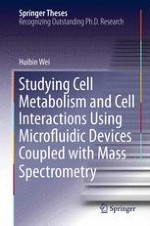2013 | Buch
Über dieses Buch
This thesis describes a new approach for cell analysis by the rapid developing microfluidic technology. The nominee has made great contributions to develop a new analysis platform which combined microfluidic devices with mass spectrometry to determine the trace compounds secreted by cells. Based on this analysis platform, she studied the specific cell secreting behaviors under controlled microenvironment, of which the secretion compounds were qualified and semi-quantified by mass spectrometry. A novel cell sorting device integrated homogenous porous PDMS membrane was invented to classify cells from real samples based on the size difference. The nominee further studied the signal transmission between different cells, and the signal chemicals were qualitative and quantitative monitored by the analysis platform. This indicates the potential significant application of the new cell analysis platform in medicine screening and early diagnosis.
Anzeige
